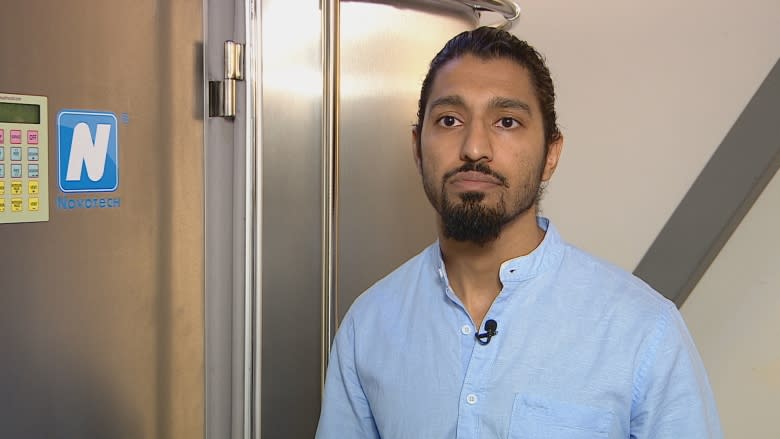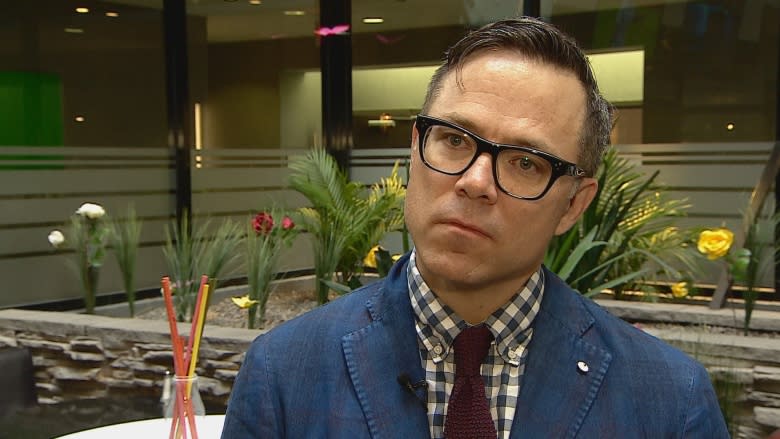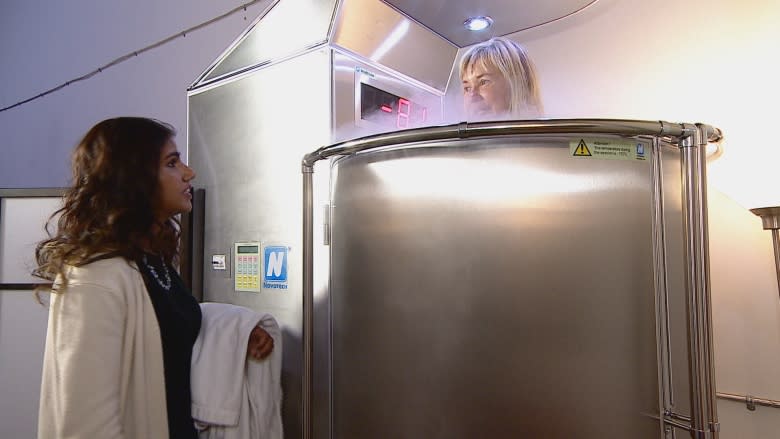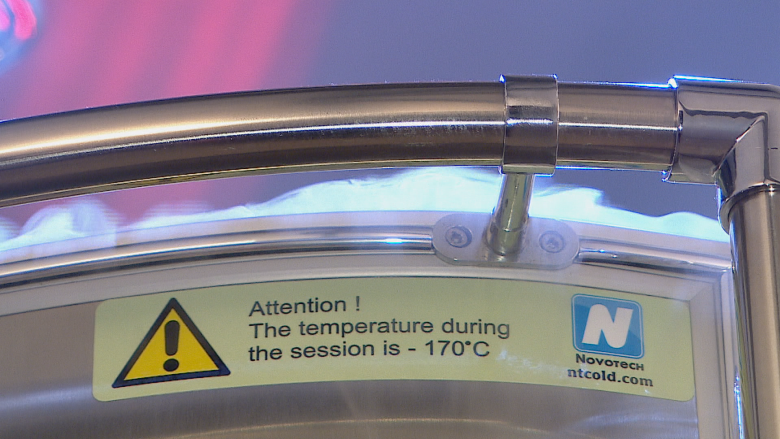Freezing frenzy: Cryotherapy makes big promises despite dearth of evidence
When torn knee cartilage threatened a Calgary man's career as a professional Brazilian Jiu Jitsu fighter, he kept his cool, stripped down to his underwear and climbed into a metal canister chilled to -145 C.
Tim Blanchard exposed his nearly naked body to temperatures lower than anything recorded in the natural world, in a controversial but increasingly popular treatment known as cryotherapy.
"I popped into cryo pretty regularly as soon as I got the injury, and because of that I found that my knee was able to recover a lot better. I didn't need surgery … so I think it definitely helps a lot with injury prevention and inflammation and I firmly believe that cryotherapy is the real deal," Blanchard said.
The rise of supercooled therapy
He's not the only believer. But cryotherapy has also created a whole lot of skepticism and sparked warnings from health regulators and researchers.
Cryotherapy got its start in Japan in the 1970s, where it was developed by a physician named Toshima Yamauchi as a way to relieve joint pain from rheumatoid arthritis.
It gained traction in Europe in the 1990s as an alternative pain treatment in health spas, and it spread in North America around 2011 thanks to use by high-performance athletes and pro sports teams.
Unlike traditional ice-bath treatments, cryotherapy doesn't require long, uncomfortable stints in frigid water. Advocates claim three minutes in a cryochamber is all that's needed to enjoy the same benefits, including reduced inflammation.
"A person that really brought it to the forefront was [retired basketball player] Kobe Bryant, back when he was playing. When it comes to that level of athlete, they know what's working and what's not because they're so in tune with their body," said Jaipaul Dhaliwal, owner of N2 Cryotherapy in northeast Calgary, one of two cryotherapy providers in the city.
Dhaliwal says he's provided supercooled therapy to players from the Calgary Flames and Stampeders as well as Olympic athletes, golfers and professional fighters.
But athletes are just the tip of the iceberg.
The therapy has also received glowing endorsements from celebrities like motivational speaker Tony Robbins, TV celebrity Dr. Oz and Hollywood glitterati like Mandy Moore and Lindsay Lohan, who regularly share their cryo-experiences with the Twittersphere.
How does it work?
Whole-body cryotherapy (WBC) can be done in a walk-in, multi-person cryocabin, or single-person cryosaunas like the one N2 uses.
The cryosauna is a metal canister 2.4 metres tall, padded on the inside and open at the top. The client steps into the cooled cubicle wearing underwear, socks and gloves to protect their extremities.
After the door closes, a lift raises the client to ensure their heads stay at room temperature. Liquid nitrogen vapour floods the sauna with a frigid fog that significantly drops the temperature in a matter of minutes.
According to Dhaliwal, the vapour doesn't freeze the skin or muscle tissue. The purpose is to trigger the thermal receptors in the skin to send the body into fight-or-flight mode, "shunting" blood from the extremities to the core to survive.
He says when the body returns to normal temperature, blood floods back to the extremities and the brain, carrying anti-inflammatory molecules, antioxidants and the chemical norepinephrine.
Fans of cryotherapy not only tout its ability to help injured muscles recuperate more quickly but also say it has many other benefits.
N2's website is similar to those of other cryotherapy providers, claiming the procedure does everything from reducing body fat to increasing testosterone in men, relieving joint pain and reducing signs of aging.
Expert is skeptical
To suppport these claims, Dhaliwal points to several studies that show the possible benefits of cryotherapy. One involves work by researchers from Szczecin University in Poland, who published a study in 2010 showing changes to cholesterol levels occurred after "at least 10 sessions of cryostimulation."
A study from the National Institute of Sport, Expertise and Performance in France reported in 2011 that the treatment was effective in reducing inflammation "in endurance athletes."
A Canadian health and science policy expert, however, is skeptical of the studies.
Timothy Caulfield is a Canada Research Chair in health law and policy at the University of Alberta and author of the book Is Gwyneth Paltrow Wrong About Everything?: When Celebrity Culture and Science Clash.
He says the studies have "very small sample sizes and/or haven't yet been replicated by other researchers."
Caulfield cited a 2015 systematic review by the Cochrane collaboration — which gathers and synthesizes medical research — on cold therapy. It found "no evidence that whole-body cryotherapy for muscle soreness after exercise is effective or safe."
Federal regulators in Canada and the U.S. are also unconvinced of cryotherapy's benefits.
"The federal government does not recognize the health claims made about cryotherapy instruments … the science hasn't been validated," says Health Canada on its website.
The U.S. Federal Drug Administration, meanwhile, issued a warning about cryotherapy in July 2016, saying it "hasn't cleared or approved any of these devices for medical treatment of any specific medical conditions."
Regulator warnings
Concerns over the treatment ramped up in 2015,after a spa worker in Las Vegas died after using a cryotherapy chamber by herself.
The coroner later found Chelsea Patricia Ake-Salvacion, 24, died accidentally from the asphyxia caused by low oxygen levels. Investigators said the death was due to an "operator error."
In December 2015, Health Canada issued a recall and safety alert, warning against "unlicensed medical devices, Cryosaunas, illegally imported to Canada and possibly linked to a death in the U.S."
The website also warns of the dangers surrounding treatments, including cold burns, permanent damage to skin, tissue and muscle, frostbite and "heart, blood circulation or brain problems."
"If the device fails, it may also lead to suffocation or the worsening of the listed risks," reads the warning.
Health Canada oversees the importation and sale of medical devices, but the legal fine print is confusing.
'Grey area' of legality
The agency has a ranking system for medical devices used on people, classified according to categories of risk. They range from Class I, the lowest risk, to Class IV, the highest risk.
Cryosaunas have been categorized as Class III medical devices, which means they need to be licensed by the federal government before they could be legally imported or sold in Canada. Health Canada has banned the importation and sale of cryosaunas until importers and manufacturers get the proper licensing.
It says no licences have been issued and no licence applications have been submitted to them for cryosaunas, but it's not illegal to own an unlicensed Class III medical device.
After the death of Ake-Salvacion, Health Canada requested that manufacturers stop the sale and immediately recall the unlicensed Class III devices. It also informed clinics using the devices of the serious potential health risk.
"They [Health Canada] have informed us of the health risks if proper safety protocol is not followed," said N2 Cryotherapy's Dhaliwal. "Right now we are in a grey area where they will not give us their blessing, but they won't shut us down."
Provincial jurisdiction
According to Health Canada, administering the therapy falls under provincial and territorial jurisdiction. In Alberta, cryotherapy is not regulated, and the health ministry says it doesn't know of any standards of practice for this service.
Because Alberta Health doesn't regulate whole-body cryotherapy, it "doesn't track the number of devices in the province or where services are provided," according to Tim Kulak, assistant director.
"Although the department has not received any complaints or reports of injury related to whole-body cryotherapy, we strongly recommend that Albertans considering this service familiarize themselves with the risks and ask the provider if the device they are using has been licensed by Health Canada," he said.
Health Canada hasn't seized any cryosaunas.
Safety precautions
Dhaliwal says N2 follows the strictest safety protocols, with checklists, the use of gloves, socks and slippers and "active monitoring."
"We talk to people during the entire three-minute procedure to monitor how they are doing, assess their comfort level and also to help the time go by faster," he said.
He believes cryotherapy will be validated but says his company is careful to tell clients that it is not a medical treatment.
"We do not treat or diagnose any medical disorder … yes, you will feel better but it is not a treatment. This should never be a first-line treatment. Your first-line treatment when it comes to any medical ailment is your doctor."
'Placebo theatre'
The U of A's Caulfield ascribes the perceived benefits of cryotherapy to "placebo theatre" and a "sciency" vibe.
"Even the facilities often look very scientific but in fact the evidence supporting it is very, very thin," says Caulfield.
Despite the lack of evidence and the warnings around safety, high performance athletes, celebrities and some regular folk continue to advocate stepping inside the tube for a frozen fix.
Blanchard, for one, thinks paying his $65 for three minutes in the tank is money well spent.
"Ice therapy doesn't feel that good, and you got to sit in there a long time. Cryotherapy, all I need to do is pop in for no more than three minutes and it just goes by like ' boom,' like super fast, and yeah it's way better on my body and it's not as painful."






